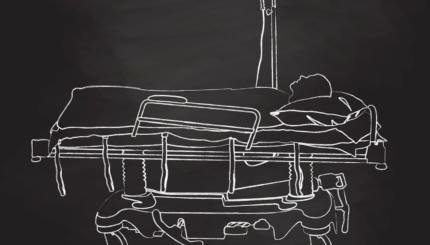There are two distinct phases in the process of mourning. The halakhah [Jewish law] has meticulously insisted upon their strict separation. The first phase begins with the death of the relative for whom one is obliged to mourn and ends with the burial. The second commences with burial and lasts seven, or with regard to some aspects, 30 days. The first we call aninut, the second aveilut.
Aninut represents the spontaneous human reaction to death. It is an outcry, a shout, or a howl of grisly horror and disgust. Man responds to his defeat at the hands of death with total resignation and with an all-consuming masochistic, self-devastating black despair. Beaten by the friend, his prayers rejected, enveloped by a hideous darkness, forsaken and lonely, man begins to question his own human singular reality. Doubt develops quickly into a cruel conviction, and doubting man turns into mocking man.
At whom does man mock? At himself. He starts downgrading, denouncing himself. He dehumanizes himself. He arrives at the conclusion that man is not human, that he is just a living creature like the beasts in the field. In a word, man’s initial response to death is saturated with malice and ridicule toward himself.
He tells himself: If death is the final destiny of all men, if everything human terminates in the narrow, dark grave, then why be a man at all? Then why make the pretense of being the choicest of all creatures? Then why lay claim to singularity and imago dei? Then why be committed, why carry the human-moral load? Are we not, the mourner continues to question himself, just a band of conceited and inflated daydreamers who somehow manage to convince themselves of some imaginary superiority over the brutes in the jungle?

Help us keep Jewish knowledge accessible to millions of people around the world.
Your donation to My Jewish Learning fuels endless journeys of Jewish discovery. With your help, My Jewish Learning can continue to provide nonstop opportunities for learning, connection and growth.
The halakhah has displayed great compassion with perplexed, suffering man firmly held in the clutches of his archenemy, death. The halakhah has never tried to gloss over the sorrowful, ugly spectacle of dying man. In spite of the fact that the halakhah has indomitable faith in eternal life, in immortality, and in a continued transcendental existence for all human beings, it did understand, like a loving, sympathetic mother, man’s fright and confusion when confronted with death.
Therefore the halakhah has tolerated those “crazy,” torturing thoughts and doubts. It did not command the mourner to disown them because they contradict the basic halakhic doctrine of man’s election as the king of the universe. It permitted the mourner to have his way for a while and has ruled that the latter be relieved of all mitzvot [commandments].
“One whose dead relative lies before him is exempt from the recital of the Shema, and from prayer, and from [phylacteries], and from all the precepts laid down in the Torah.” The Palestinian Talmud, quoted by Tosafot (Berakhot 17b), derives this law from the verse in Deuteronomy 16:3, “so that you may remember the day of your departure from the land of Egypt as long as you live.” The commitment accepted in Egypt is applicable to man who is preoccupied with life and not to one who has encountered death.
What is the reason behind this law exempting the mourner from the performance of mitzvot? Because our commitment to God is rooted in the awareness of human dignity and sanctity. Once the perplexed, despairing individual begins to question whether or not such distinctiveness or choiceness exists, the whole commitment expires.
Man who has faith in himself, who is aware of his charisma, was chosen and burdened with obligations and commandments. Despairing, skeptical man was not elected. How can man pray and address himself to God if he doubts his very humanity, if speech is stripped by his doubts of its human characteristics and turned into mere physical sound? How can the mourner pronounce a benediction or say “amen” if he is “speechless”? He is still capable of producing sounds, but a benediction consists of spiritual words and not just of physical sounds.
In a word, the motto of aninut is to be found in the old pessimistic verse in the book of Ecclesiastes: “So that man has no preeminence over the beast, for all is vanity.”
Excerpted with permission from “The Halakhah of the First Day” in Jewish Reflections on Death, edited by Jack Riemer (Schocken Books).
Sign up for a Journey Through Grief & Mourning: Whether you have lost a loved one recently or just want to learn the basics of Jewish mourning rituals, this 8-part email series will guide you through everything you need to know and help you feel supported and comforted at a difficult time.
Looking for a way to say Mourner’s Kaddish in a minyan? My Jewish Learning’s daily online minyan gives mourners and others an opportunity to say Kaddish in community and learn from leading rabbis.



